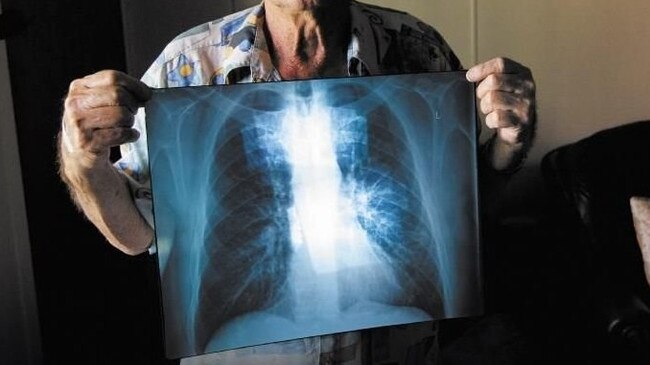Andrew Lockhart, 55, files lawsuit for black lung disease for work in CQ and UK mines
A former miner of 23 years in the UK and Central Queensland’s Bowen Basin had just returned from a trip around Australia when a routine medical check uncovered a shadow was found on his lung. Now he is suing for more than $2 million.

Rockhampton
Don't miss out on the headlines from Rockhampton. Followed categories will be added to My News.
Andrew Lockhart had plans to return to work as a miner after he returned from a trip around Australia, but bad news from a chest x-ray put a halt to that, he claims.
Mr Lockhart says he was diagnosed with black lung disease in October 2018 and it has left him with a permanent partial disability and no longer able to work in the industry.
Mr Lockhart, who is now 55 and lives in Western Australia, worked in underground mines across the United Kingdom from 1994 to 2006 and Central Queensland’s Bowen Basin up until 2017.
He claims his diagnosis is a result of exposure to coal mine dust and is suing the owners of the mines in a personal injury lawsuit.
The lawsuit was filed with the Rockhampton Supreme Court by Maurice Blackburn in November, claiming damages of $2,223,625.23.
Companies being sued include BMA Coal Operations, Kestrel Coal, Rolleston Coal Holdings and RJB Mining/ UK Coal Operations.
Mr Lockhart said he worked at the Calverton Colliery, an underground coal mine in the Nottingham Shire in the United Kingdom between 1994 and 1998.
From 2001 to 2006, he claims to have worked at the Maltby Main Colliery in South Yorkshire, United Kingdom.
He then moved to Australia where he says he worked at Central Queensland’s Crinum Mine, Peak Downs on various contracts from 2006 to 2015.
From 2011 to 2012, Mr Lockhart says he worked at Newlands Northern Underground Colliery near Glenden and then the Kestrel Colliery for two years and six months.
He also says he worked at Broadmeadows Underground Colliery near Moranbah in 2017.
According to the Statement of Claim, Mr Lockhart left the coal mining industry in 2017 for a trip around Australia.
He underwent a pre-employment coal mine medical with the intent of returning to the industry and a shadow was found on his lung in a chest x-ray.
Mr Lockhart said he undertook further testing and was diagnosed by a respiratory physician.

He claims his injuries are pneumoconiosis (known as Black Lung Disease), silicosis and coal mine dust lung disease.
He says the injuries have left him with a reduction in his lung function and he now easily becomes breathless upon exertion.
He claims to have a permanent partial disability and is not able to work in any conditions that would expose him to dust and or coal mine dust of any level.
The Statement of Claim alleges that had Mr Lockhart passed his pre-employment medical clearance as a coal mine worker, he would have reasonably expected to earn an income of $2,300 per week.
Mr Lockhart claims he was not supplied with respiratory protection wear at the Calverton Mine and he had a paper mask at the Maltby Mine but it would get clogged quickly with dirt and dust and he would discard it.
Mr Lockhart alleges at the Kestrel mine he was exposed to coal mine dust at least twice the amount of that at the UK mines.
He further alleges the companies didn’t take any or any adequate steps to monitor the level of coal mine dust at their respective mines.
According to the Statement of Claim, respirable coal mine dust should not have exceeded 3 mg/m3 of air and respirable crystalline silica dust should not have exceeded 0.1mg/ m3 of air.
Mr Lockhart alleges the companies should have known of the risk and exposure of coal mine and silica dust, that it might be hazardous to his health and that he should have been protected against the inhalation of the dust.
The Statement of Claim references expert evidence in medical journals and other reports that date back to the 1950s and 1970s, that are based on the risk of the coal mine and silica dust and miners lung diseases.
The Statement of Claim accuses the companies of putting Mr Lockhart at risk of a coal mine dust related illness.
Kestrel Coal filed a defence on January 4 and has denied its involvement in the allegations as it has been unable to confirm if Mr Lockhart was an employee of the company or if he was employed by contracting company Mastermyne.
It has further denied the injuries as it has not “not yet had the opportunity to obtain expert medical evidence if Mr Lockhart had the injury and if so, the cause of it”.
Kestrel Coal denies the amount of money that is being claimed, stating it is excessive and not in accordance with available medical evidence and that the allegations require expert evidence to plead further.
No other defences have been filed at this stage.
A final offer has not been filed for Mr Lockhart at this time.




